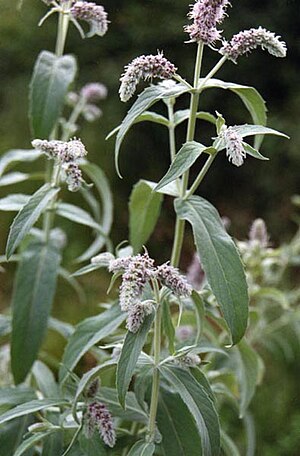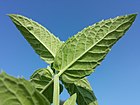Note: This is a project under development. The articles on this wiki are just being initiated and broadly incomplete. You can Help creating new pages.
Difference between revisions of "Mentha longifolia"
(Created page with "{{stub}} ==Uses== {{Uses|}}, {{Uses|}}, {{Uses|}}, {{Uses|}}, {{Uses|}}, {{Uses|}}, {{Uses|}}, {{Uses|}}, {{Uses|}}, {{Uses|}}, {{Uses|}}.<ref name="Uses"/> ==Parts Used== {{...") |
|||
| (2 intermediate revisions by 2 users not shown) | |||
| Line 1: | Line 1: | ||
| − | + | [[File:Mentha longifolia 2.jpg|thumb|right|''Mentha longifolia'']] | |
| + | '''Mentha longifolia''' is a species in the genus Mentha (mint) native to Europe excluding Britain and Ireland, western and central Asia (east to Nepal and the far west of China), and northern and southern (but not tropical) Africa. It is a very variable herbaceous perennial plant with a peppermint-scented aroma. | ||
==Uses== | ==Uses== | ||
| − | {{Uses|}}, {{Uses|}}, {{Uses|}}, {{Uses|}}, {{Uses|}}, {{Uses| | + | {{Uses|Coughs}}, {{Uses|Colds}}, {{Uses|Stomach cramps}}, {{Uses|Asthma}}, {{Uses|Flatulence}}, {{Uses|Indigestion and headaches}}. |
==Parts Used== | ==Parts Used== | ||
| − | {{Parts Used| | + | {{Parts Used|Leaves}}. |
==Chemical Composition== | ==Chemical Composition== | ||
| − | <ref name="chemical composition"/> | + | The main component of wild grown Mentha longifolia subsp. longifolia was Menthone (19.31%). Second one and others were Pulegone (12.42%), Piperitone (11.05%), Dihydrocarvon (8.32%), Limonene (6.1%), 3-Terpinolenone (5.66%), 1,8-Cineole (4.37%), Germacrene D (3.38%) and Caryopyllene (3.19%), respectively.<ref name="chemical composition"/> |
==Common names== | ==Common names== | ||
| − | {{Common names | + | {{Common names|kn=|ml=|sa=|ta=|te=|hi=|en=wild mint}} |
==Properties== | ==Properties== | ||
Reference: Dravya - Substance, Rasa - Taste, Guna - Qualities, Veerya - Potency, Vipaka - Post-digesion effect, Karma - Pharmacological activity, Prabhava - Therepeutics. | Reference: Dravya - Substance, Rasa - Taste, Guna - Qualities, Veerya - Potency, Vipaka - Post-digesion effect, Karma - Pharmacological activity, Prabhava - Therepeutics. | ||
===Dravya=== | ===Dravya=== | ||
| + | |||
===Rasa=== | ===Rasa=== | ||
| − | + | Katu (Pungent) | |
| − | |||
===Guna=== | ===Guna=== | ||
| − | |||
===Veerya=== | ===Veerya=== | ||
| − | + | Ushna (Hot) | |
===Vipaka=== | ===Vipaka=== | ||
| − | + | Katu (Pungent) | |
===Karma=== | ===Karma=== | ||
| Line 29: | Line 29: | ||
==Habit== | ==Habit== | ||
| − | {{Habit|}} | + | {{Habit|Herb}} |
==Identification== | ==Identification== | ||
===Leaf=== | ===Leaf=== | ||
| − | {{Leaf|||}}<ref name="Leaf"/> | + | {{Leaf|Simple|oblong-elliptical to lanceolate|5–10 cm long and 1.5–3 cm broad, thinly to densely tomentose, green to greyish-green above and white below.}}<ref name="Leaf"/> |
===Flower=== | ===Flower=== | ||
| − | {{Flower||||}} | + | {{Flower|Unisexual|3–5 mm long|lilac, purplish, or white||produced in dense clusters (verticillasters) on tall, branched, tapering spikes; flowering in mid to late summer. It spreads via rhizomes to form clonal colonies.}} |
| − | |||
| − | |||
===Other features=== | ===Other features=== | ||
| Line 46: | Line 44: | ||
==Where to get the saplings== | ==Where to get the saplings== | ||
| − | |||
==Mode of Propagation== | ==Mode of Propagation== | ||
| − | {{Propagation|}} | + | {{Propagation|Seeds}}. |
==How to plant/cultivate== | ==How to plant/cultivate== | ||
| − | <ref name="How to plant/cultivate"/> | + | An easily grown plant, it succeeds in most soils and situations so long as the soil is not too dry. Grows well in heavy clay soils. A sunny position is best for production of essential oils, but the plants also succeed in partial shade. There is some confusion over the name of this plant<ref name="How to plant/cultivate"/> |
==Commonly seen growing in areas== | ==Commonly seen growing in areas== | ||
| − | {{Commonly seen| | + | {{Commonly seen|grasslands}}. |
==Photo Gallery== | ==Photo Gallery== | ||
<gallery class="left" caption="" widths="140px" heights="140px"> | <gallery class="left" caption="" widths="140px" heights="140px"> | ||
| − | + | File:Mentha longifolia sl14.jpg | |
| + | File:Mentha longifolia sl11.jpg | ||
| + | File:Mentha longifolia sl7.jpg | ||
| + | File:Mentha longifolia 1.jpg | ||
</gallery> | </gallery> | ||
==References== | ==References== | ||
<references> | <references> | ||
| − | + | <ref name="chemical composition">[https://www.researchgate.net/publication/316253437_Chemical_composition_of_essential_oil_of_Mentha_longifolia_L_subsp_longifolia_growing_wild#:~:text=The%20main%20component%20of%20wild,Caryopyllene%20(3.19%25)%2C%20respectively. "sciencedirect"]</ref> | |
| − | <ref name="chemical composition">[" | + | <ref name="Leaf">[https://en.wikipedia.org/wiki/Mentha_longifolia "wayback machine"]</ref> |
| − | + | <ref name="How to plant/cultivate">[https://pfaf.org/user/Plant.aspx?LatinName=Mentha+longifolia "Cultivation of Mentha"]</ref> | |
| − | <ref name="Leaf">[" | ||
| − | |||
| − | <ref name="How to plant/cultivate">[ "Cultivation"] | ||
| − | |||
</references> | </references> | ||
==External Links== | ==External Links== | ||
| − | * [ ] | + | * [https://www.iucnredlist.org/species/164306/42320630 Mentha longifolia] |
| − | + | ||
| − | |||
[[Category:Herbs]] | [[Category:Herbs]] | ||
| + | [[Category:Lamiaceae]] | ||
Latest revision as of 14:28, 4 June 2020
Mentha longifolia is a species in the genus Mentha (mint) native to Europe excluding Britain and Ireland, western and central Asia (east to Nepal and the far west of China), and northern and southern (but not tropical) Africa. It is a very variable herbaceous perennial plant with a peppermint-scented aroma.
Contents
- 1 Uses
- 2 Parts Used
- 3 Chemical Composition
- 4 Common names
- 5 Properties
- 6 Habit
- 7 Identification
- 8 List of Ayurvedic medicine in which the herb is used
- 9 Where to get the saplings
- 10 Mode of Propagation
- 11 How to plant/cultivate
- 12 Commonly seen growing in areas
- 13 Photo Gallery
- 14 References
- 15 External Links
Uses
Coughs, Colds, Stomach cramps, Asthma, Flatulence, Indigestion and headaches.
Parts Used
Chemical Composition
The main component of wild grown Mentha longifolia subsp. longifolia was Menthone (19.31%). Second one and others were Pulegone (12.42%), Piperitone (11.05%), Dihydrocarvon (8.32%), Limonene (6.1%), 3-Terpinolenone (5.66%), 1,8-Cineole (4.37%), Germacrene D (3.38%) and Caryopyllene (3.19%), respectively.[1]
Common names
| Language | Common name |
|---|---|
| Kannada | |
| Hindi | |
| Malayalam | |
| Tamil | |
| Telugu | |
| Marathi | NA |
| Gujarathi | NA |
| Punjabi | NA |
| Kashmiri | NA |
| Sanskrit | |
| English | wild mint |
Properties
Reference: Dravya - Substance, Rasa - Taste, Guna - Qualities, Veerya - Potency, Vipaka - Post-digesion effect, Karma - Pharmacological activity, Prabhava - Therepeutics.
Dravya
Rasa
Katu (Pungent)
Guna
Veerya
Ushna (Hot)
Vipaka
Katu (Pungent)
Karma
Prabhava
Habit
Identification
Leaf
| Kind | Shape | Feature |
|---|---|---|
| Simple | oblong-elliptical to lanceolate | 5–10 cm long and 1.5–3 cm broad, thinly to densely tomentose, green to greyish-green above and white below. |
Flower
| Type | Size | Color and composition | Stamen | More information |
|---|---|---|---|---|
| Unisexual | 3–5 mm long | lilac, purplish, or white | produced in dense clusters (verticillasters) on tall, branched, tapering spikes; flowering in mid to late summer. It spreads via rhizomes to form clonal colonies. |
Other features
List of Ayurvedic medicine in which the herb is used
Where to get the saplings
Mode of Propagation
How to plant/cultivate
An easily grown plant, it succeeds in most soils and situations so long as the soil is not too dry. Grows well in heavy clay soils. A sunny position is best for production of essential oils, but the plants also succeed in partial shade. There is some confusion over the name of this plant[3]
Commonly seen growing in areas
Photo Gallery
References
External Links
- Ayurvedic Herbs known to be helpful to treat Coughs
- Ayurvedic Herbs known to be helpful to treat Colds
- Ayurvedic Herbs known to be helpful to treat Stomach cramps
- Ayurvedic Herbs known to be helpful to treat Asthma
- Ayurvedic Herbs known to be helpful to treat Flatulence
- Ayurvedic Herbs known to be helpful to treat Indigestion and headaches
- Herbs with Leaves used in medicine
- Herbs with common name in English
- Habit - Herb
- Index of Plants which can be propagated by Seeds
- Herbs that are commonly seen in the region of grasslands
- Herbs
- Lamiaceae




